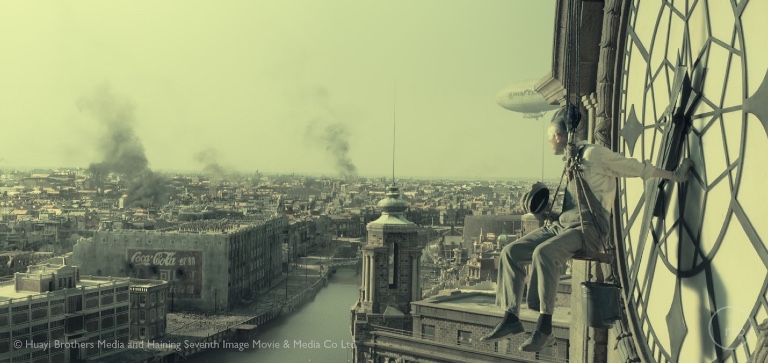
Since it opened in Asia on August 21, The Eight Hundred has earned close to $300 million. On its second weekend, it out-grossed Tenet‘s global opening weekend of $53 million. Directed and co-written by Guan Hu, it is the first Chinese feature shot in digital IMAX. In commanding detail and intensity, the movie plays out the four-day siege of the Sihang Warehouse in Shanghai in October, 1937, the turning point in the war between China and Japan.
Guan had been planning the film for some ten years. VFX Supervisor Tim Crosbie first got involved with the project in late 2016, when John Dietz at BangBang Pictures asked him to take over on-set supervision for what was scheduled to be a four- to five-month shoot. “Anyway, two-and-a-half years later,” Crosbie joked.
On a Zoom call, Crosbie explained that Guan Hu (nicknamed “Tiger”) and director of cinematography Cao Yu needed storyboards for action sequences where visual effects would be involved. Crosbie accompanied them and production designer Lin Mu to Suzhou [site of the Huayi Brothers Movie World] for a reconnaissance of the Sihang warehouse set. That’s when Crosbie started to realize the scale of the project.
“I think the warehouse set was maybe a mile long by a half-mile wide,” he said. “Tiger saw that they weren’t going to finish construction by the start of shooting, which was only weeks away. So the shoot was postponed to September, 2017. That’s a long hiatus, but it gave us a massive time for preproduction.”

Preliminary storyboards convinced Guan to reshuffle his script, in part to help viewers follow the complex storyline. In the meantime, Cao and Crosbie shot camera tests and effects tests, determining how to achieve the long takes Guan preferred. They worked from hundreds of photos and street plans to make sure their vision of Shanghai was accurate, ultimately building a 3D set of the entire city for reference.
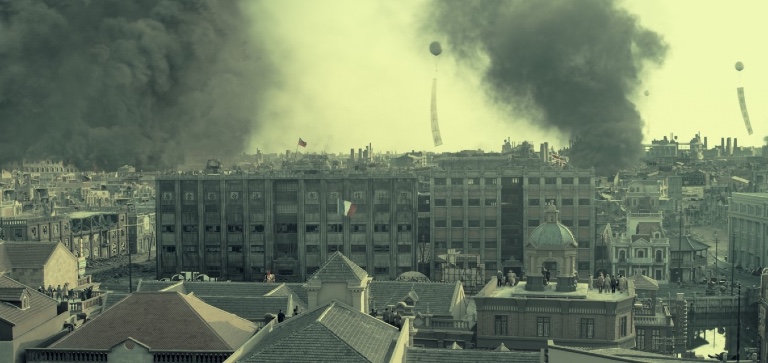
“There’s a bit of artistic license when it comes to the concessions,” Crosbie admitted, referring to the protected International Settlement across the river from the warehouse. “That had a sort of 1920s Great Gatsby feel, and it was built up more than probably existed at the time. But we needed it to help tell the story.”
With roughly a square mile of physical sets, Cao had plenty of room to position his camera without relying too much on visual effects components — at least until the wide shots.
“We used something like two kilometers of green screen,” Crosbie said. “Fifteen meters high, around the set. That was a massive undertaking. Depending on the schedule, we could move the screens around to make sure Cao could shoot whatever he liked.
Cao shot with ARRI Alexa 65 camera systems, which according to Crosbie made his effects work easier.
“That amount of resolution improved the accuracy of the tracking, the accuracy of how we lit, all that sort of stuff, because the cameras captured so much detail,” he said. “It gave us a lot to work with in visual effects. Just the plates themselves that we shot were really the reference that we then used to texture the assets.”
During the third day of fighting, Japanese planes attack the warehouse in a carefully choreographed sequence that includes aerial views of much of Shanghai.
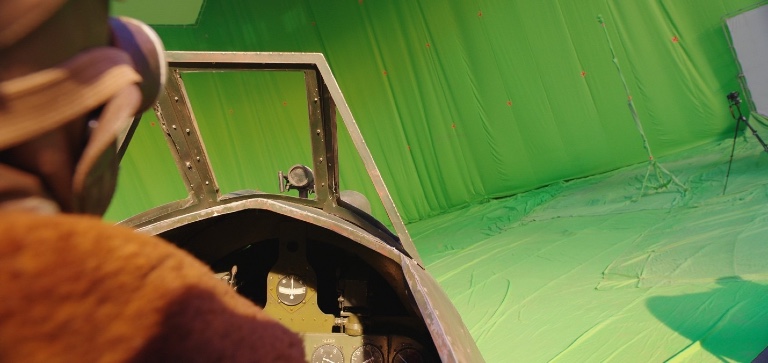
“In the old days, for a city vista, you would do matte paintings, paintings on glass, whatever,” Crosbie noted. “When we were initially planning out the sequence, we’d say, ‘Here’s our square mile,’ and then we’d digitally back it up with paintings in the distance. But Cao did not want a short depth-of-field, he wanted to see everything. So did Guan. And because of the long, sweeping camera moves that went from one side of the set to the other, basically that meant we had to build Shanghai out to pretty much the horizon, 360 degrees. We had a DMP cyclorama for the sky, but the city itself, that was procedurally fully built.”
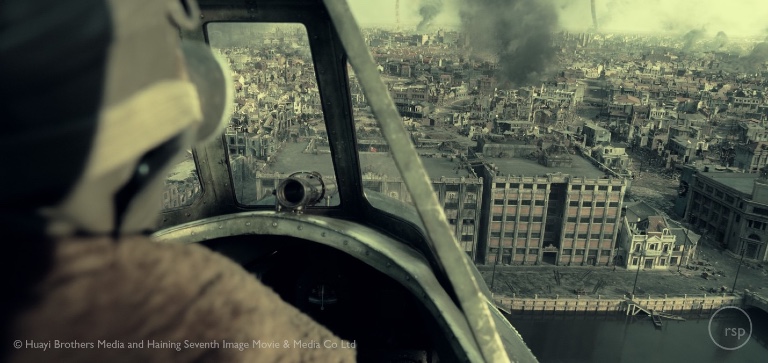
The attack incorporates several points of view, from spectators in the concession to pilots bearing down on their targets to Chinese soldiers on the warehouse rooftop.
“The choreography for that third day on the roof was always going to be tricky,” Crosbie admitted. “To play it out so the audience could follow and understand required a lot of decisions. You’re looking up in the air: where are the planes? You’re looking down from the planes: what are you seeing? It sounds fairly simple, especially when you see the results, but we spent months trying different techniques.”
Crosbie said he had dual goals for his work. “When people watch this, if they notice there are visual effects, they’re getting pulled away from the story. That means I haven’t done my job right.”
He also focused on planning “to the nth degree. We wanted to make it tighter and tighter and tighter, so when it came time to shoot, it meant that the director and the DP could react to conditions on the day, how people were actually moving. We could have a bit of fun on the set. We could change and adjust because we knew the constraints with which we could work.
Crosbie has been working in visual effects for decades, for the last several years with Rising Sun Pictures, a studio based in Adelaide, Australia. His recent films include X-Men: Apocalypse and The Wolverine. He agreed that on scale alone, The Eight Hundred was an unexpectedly big project.
“Bigger because I was the overall visual effects supervisor,” he added. “I was relying on vendors, the companies we were working with. Whereas on the Marvel movies I’ve worked on, I was one of the vendors, one of the guys the supervisors depended on. It’s been interesting looking at it from the other perspective, the studio’s side.”
That perspective meant that Crosbie had to adjust some of his expectations.
“You realize you have to divorce yourself a little bit from the minutiae, the details,” he said. “You can’t micromanage. It’s just not possible. You have to step back and let the vendors get on with what they do. All I could do was be there to ensure they understood what the director needed, that sort of stuff. It’s a different process.”
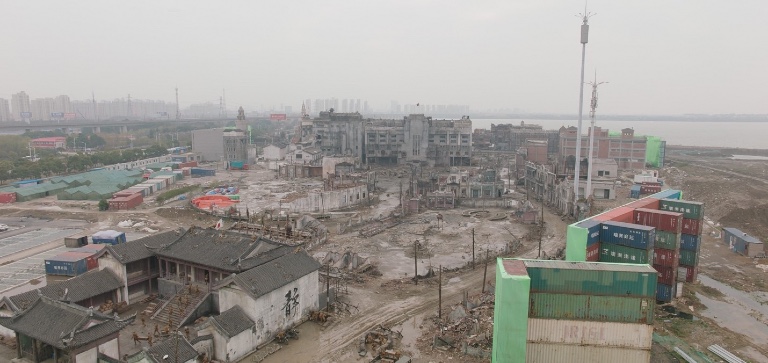
Crosbie was on the set every day of the production, estimating that a quarter of the shoot involved extensive VFX. When it came to post, Guan wanted Cao Yu and Lin Mu to be available.
“All four of us would get together at least once a week during post,” he said. “Make sure what we were hitting was what everybody’s vision wanted to be. I’ve never experienced that before, and I really wish all shows were like that. Quite often you’ll be deep in post-production, thinking, ‘This looks great, but is this what the actual vision was for the DP?’ You never find out until you hit the DI and get notes that you should have done it this way or that way.”
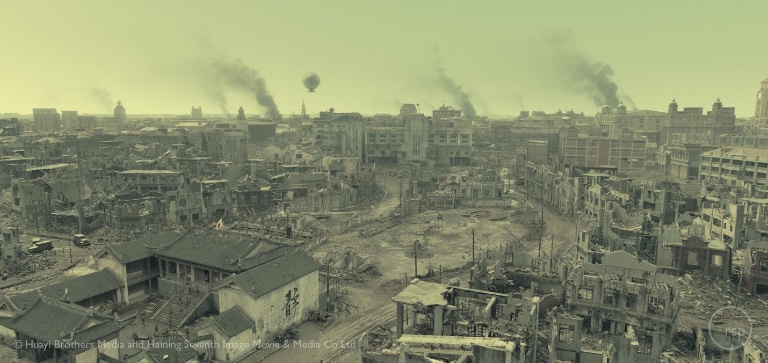
The Eight Hundred‘s release was delayed some fifteen months, and even now Chinese cinemas can’t operate at full capacity. Other Rising Sun projects, like Black Widow, have yet to open.
“Shows that have been shot and are in the can, they’re okay for us because they’re still “‘feeding the beast,'” Crosbie pointed out. “We are still working. We actually haven’t closed our doors, we’ve been working all the way through, a lot of off-site home set-ups, social distancing in the office, all that fun stuff.”
As for completed films, Crosbie hoped they will eventually come out, either via a streaming service or in cinemas.
“With regards to The Eight Hundred and Tenet, other films that are starting to go out now, worldwide, I think the studios are doing a great thing in thinking where they can release them. Rather than the old way of saying, ‘It’ll go out in the US first and then around to the rest of the world.’ Conditions have clearly changed, and studios are pivoting to make sure they can bring the product out in a way that will let people enjoy it on the big screen. Some blockbusters need to be seen on a big screen. Watching them on a television is not the same.”





